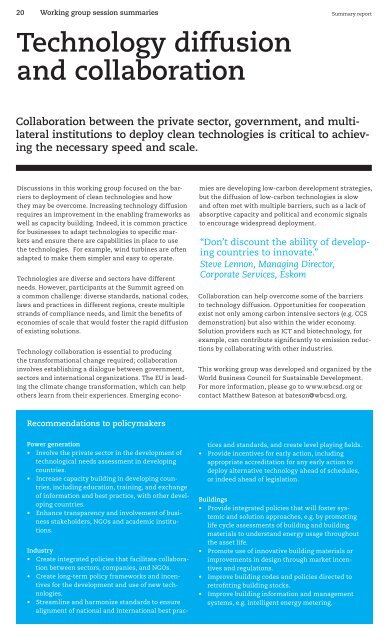pdf download - Sustainia
pdf download - Sustainia
pdf download - Sustainia
Create successful ePaper yourself
Turn your PDF publications into a flip-book with our unique Google optimized e-Paper software.
20 Working group session summariesSummary reportTechnology diffusionand collaborationCollaboration between the private sector, government, and multilateralinstitutions to deploy clean technologies is critical to achievingthe necessary speed and scale.Discussions in this working group focused on the barriersto deployment of clean technologies and howthey may be overcome. Increasing technology diffusionrequires an improvement in the enabling frameworks aswell as capacity building. Indeed, it is common practicefor businesses to adapt technologies to specific marketsand ensure there are capabilities in place to usethe technologies. For example, wind turbines are oftenadapted to make them simpler and easy to operate.Technologies are diverse and sectors have differentneeds. However, participants at the Summit agreed ona common challenge: diverse standards, national codes,laws and practices in different regions, create multiplestrands of compliance needs, and limit the benefits ofeconomies of scale that would foster the rapid diffusionof existing solutions.Technology collaboration is essential to producingthe transformational change required; collaborationinvolves establishing a dialogue between government,sectors and international organizations. The EU is leadingthe climate change transformation, which can helpothers learn from their experiences. Emerging econo-mies are developing low-carbon development strategies,but the diffusion of low-carbon technologies is slowand often met with multiple barriers, such as a lack ofabsorptive capacity and political and economic signalsto encourage widespread deployment.“Don’t discount the ability of developingcountries to innovate.”Steve Lennon, Managing Director,Corporate Services, EskomCollaboration can help overcome some of the barriersto technology diffusion. Opportunities for cooperationexist not only among carbon intensive sectors (e.g. CCSdemonstration) but also within the wider economy.Solution providers such as ICT and biotechnology, forexample, can contribute significantly to emission reductionsby collaborating with other industries.This working group was developed and organized by theWorld Business Council for Sustainable Development.For more information, please go to www.wbcsd.org orcontact Matthew Bateson at bateson@wbcsd.org.Recommendations to policymakersPower generation• Involve the private sector in the development oftechnological needs assessment in developingcountries.• Increase capacity building in developing countries,including education, training, and exchangeof information and best practice, with other developingcountries.• Enhance transparency and involvement of businessstakeholders, NGOs and academic institutions.Industry• Create integrated policies that facilitate collaborationbetween sectors, companies, and NGOs.• Create long-term policy frameworks and incentivesfor the development and use of new technologies.• Streamline and harmonize standards to ensurealignment of national and international best practicesand standards, and create level playing fields.• Provide incentives for early action, includingappropriate accreditation for any early action todeploy alternative technology ahead of schedules,or indeed ahead of legislation.Buildings• Provide integrated policies that will foster systemicand solution approaches, e.g. by promotinglife cycle assessments of building and buildingmaterials to understand energy usage throughoutthe asset life.• Promote use of innovative building materials orimprovements in design through market incentivesand regulations.• Improve building codes and policies directed toretrofitting building stocks.• Improve building information and managementsystems, e.g. intelligent energy metering.



